Western Digital Expands HGST Helium Drive Lineup with 10TB Ultrastar He10
by Ganesh T S on December 2, 2015 3:01 AM EST- Posted in
- Enterprise
- Storage
- HDDs
- Western Digital
- HGST
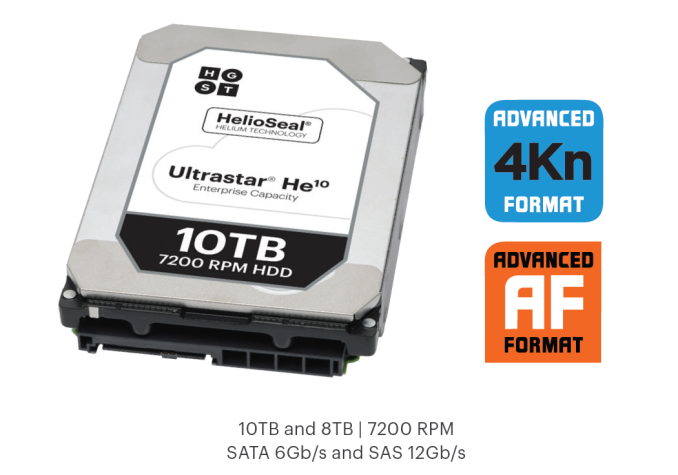
HGST, a Western Digital subsidiary, has been shipping hard drives sealed with helium for a couple of years now. Their helium drives have so far come in two flavors - the Ultrastar He drives using platters with traditional perpendicular magnetic recording (PMR) technology and the Ultrastar Archive Ha drives using platters with shingled magnetic recording (SMR). There are two main patented innovations behind the helium drives, HelioSeal and 7Stac. The former refers to placement of the platters in a hermetically sealed enclosure filled with helium instead of air. The latter refers to packaging of seven platters in the same 1" high form factor of traditional 3.5" drives.
The Ultrastar He6 6TB drive was introduced in November 2013, and this was followed by the He8 8TB drive late last year. In June 2015, the Ultrastar Ha10 SMR drive with HelioSeal technology was introduced. Around the same time, HGST also made it known that more than 1M HelioSeal units had been deployed. 1.33 TB platters have become available in air drives now, and HGST is taking advantage of that in the 10TB Ultrastar He10. The launch of the Ultrastar He10 PMR drive today also brings the news that more than 4M HelioSeal units have been deployed in various datacenters - pointing to the rapid rise in adoption rate of this technology.
We have already seen in our reviews that the helium drives offer the best performance to power ratio and watts per TB metric amongst all the drives in their capacity class. HGST also claim a 2.5M hour MTBF - much higher than traditional enterprise PMR drives. The initial cost of the helium drives have been substantially higher compared to the standard drives of the same capacity, but the TCO (total cost of ownership) metric is highly in favor of these drives - particularly for datacenter customers who need the drives to be active 24x7. HGST's press briefing included a slide that presented the potential TCO benefits that come about due to the increased capacity per rack, lower consumption per rack and lower power consumption per TB of the new He10 drives.
HGST indicated that the ramp in volume should help the initial cost to approach that of the air drives in the near future. For datacenter customers, that would mean an acceleration in obtaining the TCO benefits.
Coming to the core specifications, the Ultrastar He10 will come in both SATA 6Gbps and SAS 12Gbps varieties. The drives have 4KB sectors, though SKUs with 512-byte emulation are also available. Various data security options such as instant secure erase, self-encryption, secure erase and TCG encryption with FIPS are available.
The standard Ultrastar He drive features such as rotational vibration safeguard (for better RV tolerance in multi-drive servers) and the rebuild assist mode (for faster RAID rebuild) are retained. The drives come with a 256MB DRAM buffer.
Hard drives are struggling to reach the 10TB capacity point with traditional PMR technology. While Seagate did announce a few 8TB PMR drives earlier this quarter, it really looks like vendors need to move to some other technology (shingled magnetic recording or heat-assisted magnetic recording (HAMR)) in order to keep the $/TB metric competitive against the upcoming high-capacity SSDs. As of now, helium seems to be the only proven solution causing minimal performance impact and HGST appears to have a strong hold in this particular market segment.


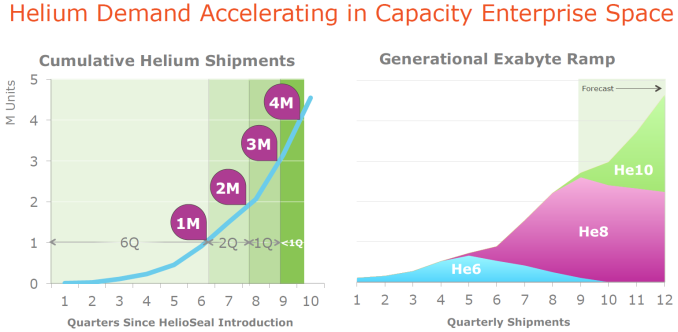
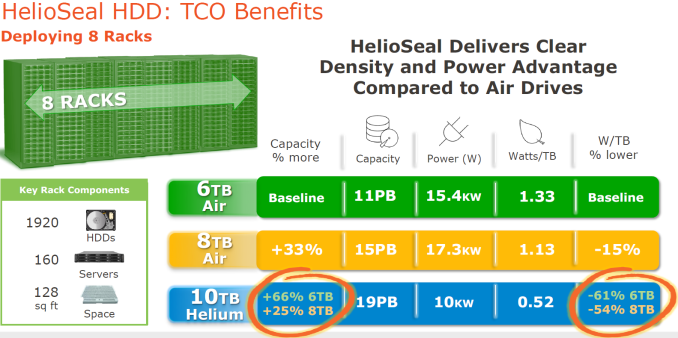
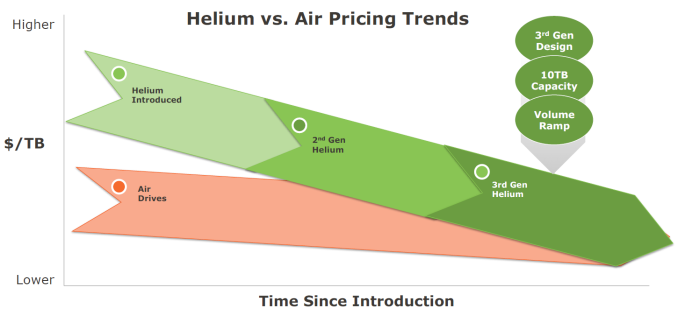
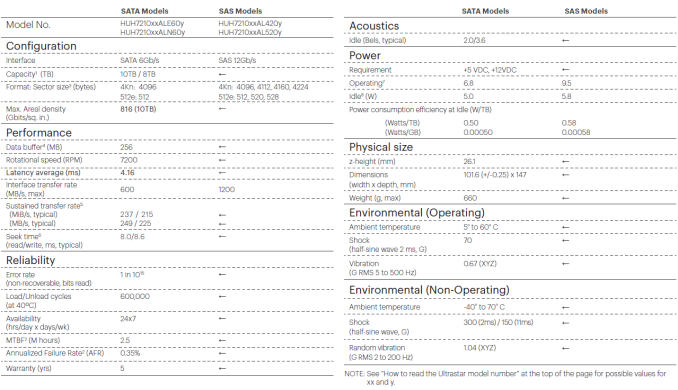
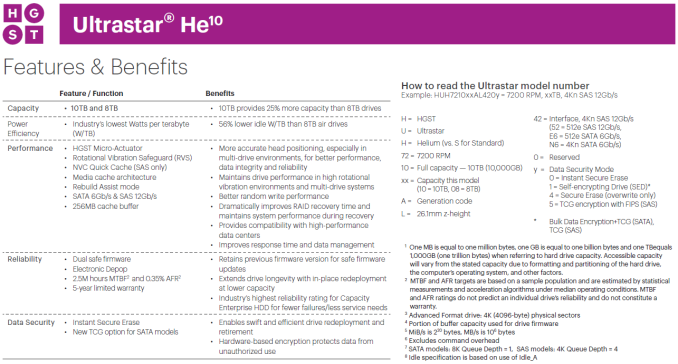








113 Comments
View All Comments
realityengine - Sunday, December 6, 2015 - link
5.25" 1/2 height drives occupy approx 4x the volume as 3.5" disk drives.Spouting off about a 30TB 5.25" drive that would "tremendously boost ... capacity" when you can put 40TB worth of existing much more reliable 3.5" drives in the same number of cubic inches is sufficient reason by itself to not consider a niche product. Data centers are driven by cost, power and reliabilty. None of those would be better on a per byte basis compared with 3.5" drives. Cramming more actuators increases costs, decreases reliability and has been tried in the past and discarded for those and additional reasons.
Ignoring the sound technical reasons why bigger spinning platters is not a good idea or the substantial increase in cost involved in using more heads and actuators the reality is that 5.25" drives do NOT give you an increase in storage per cubic inch.
There is a reason 14" disk packs have gone the way of the dodo bird and so have 8" and 5.25" disk drives.
Consumer products will likely see a complete disappearance of rotating magnetic media within the next couple of years. Flash is now cheaper than rotating media drives for smaller capacities and larger capacity drives just aren't needed by most consumers. SSD covers all the bases, cheap, reliable, fast, for consumers.
Only data centers and a few power user applications will need the higher capacity magnetic media drives and they are driven so strongly by costs that they aren't going to give the SLIGHTEST consideration to more expensive, less reliable, bulky 5.25" drives.
JanW1 - Wednesday, December 2, 2015 - link
"the TCO (total cost of ownership) metric is highly in favor of these drives"Do you have any own data to back this up (particularly on reliability), or are you just repeating HGST's com?
ganeshts - Wednesday, December 2, 2015 - link
You can look at the calculations as made in the slide reproduced in the article. I have no reason to doubt HGST's calculation.In general, datacenter customers care a lot about saving on space (i.e, they want to cram more terabytes per rack) and power (i.e, they want to have the lowest possible watt / TB) - because, for the 24x7 operation, the rack ownership/rental cost and cooling costs as well as power bills will be much more than what the member drives themselves cost.
JanW1 - Friday, December 4, 2015 - link
Surprising.You state that "helium drives offer the best performance to power ratio and watts per TB metric amongst all the drives in their capacity class". Now in the article you cite for that, the RAID 5 volume Resync consumed 1096Wh (10h 24m 22s X 105.42 W) for the Seagate Enterprise Capacity 3.5" HDD v4 6 TB, and 1198Wh (12h 34m 20s X 95.36 W) for the HGST Ultrastar He6 6 TB. That's a 9% power consumption _increase_. That seems to be a contradiction?
And you don't have a reason to doubt HGST's claim of a 65% power _decrease_ between a 6TB air drive and a 10TB He drive? I'm sure they found some power hogging ancient 6TB drive that can validate those numbers, but you seem to think this is actually a valid comparison with current state of the art hardware, in contradiction to your own measurements?
Sorry, this looks like publicity space bought by HGST, no more.
JanW1 - Friday, December 4, 2015 - link
Sorry, 35% power decrease claimed by HGST.boozed - Wednesday, December 2, 2015 - link
A sustained transfer rate of 249MB/s? REALLY?jabber - Wednesday, December 2, 2015 - link
Yeah but it's the access times that really count.extide - Wednesday, December 2, 2015 - link
Yeah as the data density goes up the sequential transfer rates go up as well. Of course that is strictly sequential access only.boozed - Wednesday, December 2, 2015 - link
Oh of course, I should have realised it was proportional to density.Hrel - Wednesday, December 2, 2015 - link
I miss the days when Anandtech was more about in depth technical reviews and less (not at all) about press releases.I can think of at least 7 laptops you guys should have done full reviews of by now, that have not even been mentioned.
I don't see anything even on here about the various Sony smartphones, certainly no full reviews.
It's so sad, bring back Anand!